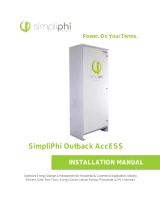8
6.2. Safety warnings
1. Do not disassemble the batteries. The inside of the battery has a protective
mechanism and a protective circuit to avoid danger. Improper
disassembly will damage the protection function permanently, leaving
the battery without safety conditions.
2. Never short-circuit the poles of the battery. Avoid contact of positive and
negative poles with metals.
3. Keep the batteries away from fire and extreme temperatures. Monitor the
distance to thermal bulbs, stoves, etc.
4. Keep the battery away from the water. Always be careful that the battery
is not located in damp places where the dew point can be reached.
5. Do not use batteries that have physical damage that may be due to falls
or bumps.
6. Do not weld near the battery.
7. Overheating will result in the loss of the protective function of its life cycle,
even, it could render the battery useless and in extreme cases self-ignition
of the battery occurs.
8. Never connect this battery in series and connect it in parallel only with
identical batteries up to a maximum number of 6.
9. If the battery has liquid leakage, avoid contact with it completely. It can
be harmful to the skin, and if you touch the eyes, wash, and go to the
hospital immediately for treatment.
6.3. Environmental Protection
Turbo Energy's batteries comply with EU ROHS regulations.
6.4. Contact details
For any incident with the battery write, indicating your contact details, an email








